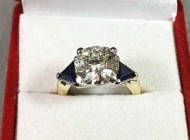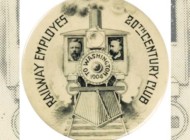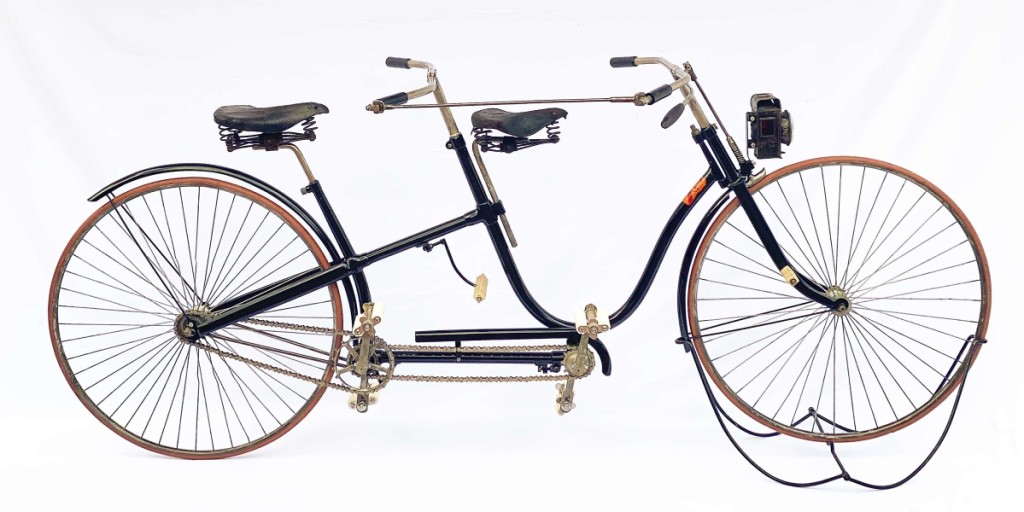
Purchased by an American collector was the sale’s top lot at $20,650, an 1889 Psycho Safety Tandem by the Starley Brothers, St John’s Works, Coventry, England. Fallon said less than a dozen examples are known from what is thought to be only 100 ever made. “You don’t see tandems from that period,” the auctioneer said.
Review by Greg Smith
COPAKE, N.Y. – Among the audiences who purchase from Copake Auction throughout the year, auctioneer Seth Fallon said the bicycle collecting community, more hobbyists than pure collectors, were not the most tech-savvy.
“It’s not an insult,” he said, “But they’re just not as internet auction savvy as a regular auction buyer is.”
He confessed presale anxiety as his 29th annual Bicycle Auction went online-only following a cancellation the year before.
“With some things starting to open back up, some people didn’t understand why we weren’t doing it this year,” he said, “But the timing was off.”
The collectors swap meet regularly held in conjunction with the sale was postponed.
By the time the June 26 sale came around, the firm had around 2,500 absentee bids from all over the world, thousands of bidders registered and more than 1,000 people participating online live.
“Those are good numbers for this material because it’s a fairly narrow collecting group,” he said.
The auction went on to produce more than $400,000. It did just fine.
Sprinkled inside the 840 lots were 107 examples from actor Anthony LaPaglia. “He collected lightweights, racing bicycles – more modern stuff,” Fallon said. “That’s a new market for us, we’ve always cut our teeth on the antique stuff.”
Fallon said that younger buyers, deterred by the high prices of high wheels and pristine examples restored by collectors, have turned to collecting vintage bicycles from the 1950s on forward. Many of them from this period are still able to be ridden and the category is gaining steam.
“There’s a whole new crowd into the racing stuff, the fixed gear, the carbon fiber,” Fallon said.
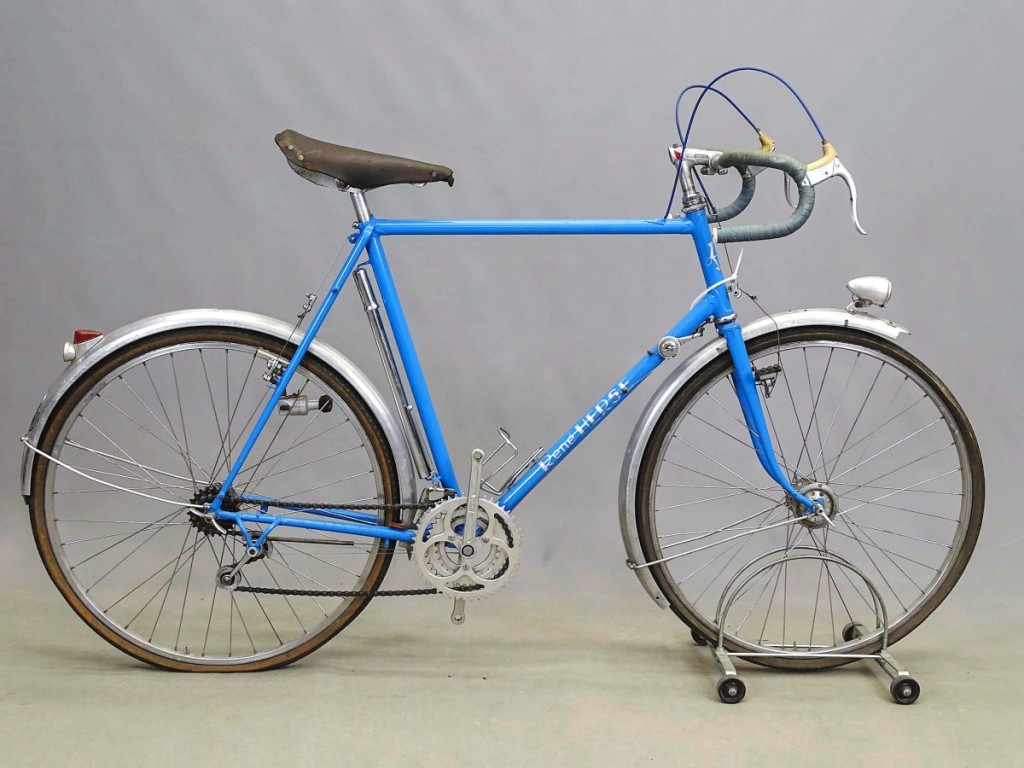
From French maker René Herse came this 24-inch lightweight bicycle with fenders that sold for $5,228. It was the top offering from the LaPaglia collection.
Top among LaPaglia’s examples at $5,228 was a René Herse 24-inch lightweight bicycle with fenders, lights and air pump. Herse began his career working on prototype aircraft, but soon turned to bicycles. He was known as a “constructeur,” or a complete builder of the entire bicycle and its components. A Billato 22½-inch lightweight bicycle with 12-speed gear and Campagnolo accessories sold for $3,075. An attractive 23½-inch Frejus lightweight bicycle with Brooks saddle and Campagnolo accessories would take $1,845. Emmo Ghelfi founded the company in Torino, Italy, in 1896 and was another “constructeur” outfit that produced each component. They were among the first in Italy to manufacture bicycles.
Fallon’s more regular customers interested in antique bicycles came out in force.
The sale’s top lot at $20,650 was an 1889 Psycho Safety Tandem by the Starley Brothers, St John’s Works, Coventry, England. It is believed the company manufactured less than 100 examples of this model with less than a dozen known in the world. “You don’t see tandems from that period, they are hard tire safety tandems which came right before the pneumatic era. It’s the only one I’ve ever seen in 29 years,” Fallon said. It sold to an American collector.
Selling for $12,915 was a circa 1891 Western Wheel Works hard tire safety bicycle, “Our Special #10,” in restored condition. Fallon called it a 10-out-of-10 form and a “blue-chip” hard tire safety form. “Whether it’s Western Wheel or Victor, that would have been pretty expensive in its period. It was the Ferrari of bicycles in that period,” Fallon said. It sold to a collector who owns a bicycle shop, the auctioneer said, noting that many vintage and antique bicycle collectors are in that profession.
Top among the high wheels was an $8,610 result for a circa 1885 Pony Star in riding condition with a 44-inch front wheel. Fallon said these can go anywhere from $5,000 to $15,000 depending on condition, and he thought this brought a fair price.
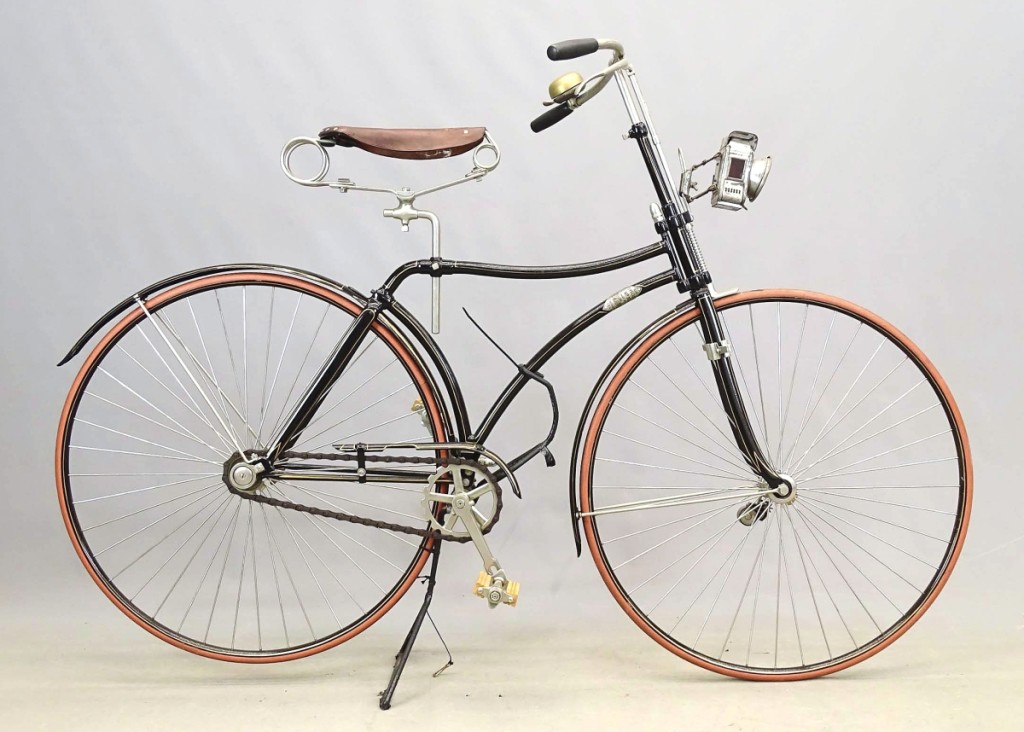
Fallon called this 1891 Western Wheel Works “Our Special #10” a 10-out-of-10 form and a “blue-chip” hard tire safety form. In restored condition with plenty of accessories, it sold for $12,915.
High wheel accessories were in demand as well, with a 54-inch Lakin’s high wheel cyclometer selling for $3,321. A Butcher 54-inch high wheel cyclometer sold for $2,337.
Consigned from a Long Island collector was a 1939 Montgomery Wards Hawthorne “Zep” men’s deluxe that sold for $10,148. “Just original condition,” Fallon said. “Airflow period, it’s exactly what they like for that period. A rare model and accessorized, this had a dashboard, it had the bells and whistles and very good paint.” Fallon said that boys bikes are more difficult to find unrestored because they typically rode them hard.
International buyers showed up online and purchased about ten percent of the sale, Fallon related. With the sport and hobby more pronounced in Europe, that side of the Atlantic holds a more developed market for collectors. Still, five or six museums are regular participants in Copake’s sales, making the regular pilgrimage to the auction house. One gentleman from the Netherlands purchased about 30 bicycles and he’ll put them into a shipping container to send home.
Other domestic buyers are working with a shipper the auction house regularly works with. They will disassemble, box up and ship around 60 bicycles this auction, with the remainder picked up by various other shippers and buyers.
Fallon said he is going to hold another bicycle auction in conjunction with a collectors swap meet on September 25.
All prices reported include buyer’s premium. For information, www.copakeauction.com or 518-329-1142.


















